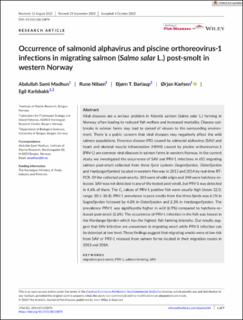| dc.contributor.author | Madhun, Abdullah Sami | |
| dc.contributor.author | Nilsen, Rune | |
| dc.contributor.author | Barlaup, Bjørn Torgeir | |
| dc.contributor.author | Karlsen, Ørjan | |
| dc.contributor.author | Karlsbakk, Egil Erlingsson | |
| dc.date.accessioned | 2024-01-26T09:45:03Z | |
| dc.date.available | 2024-01-26T09:45:03Z | |
| dc.date.created | 2023-11-01T10:28:52Z | |
| dc.date.issued | 2023 | |
| dc.identifier.citation | Journal of Fish Diseases. 2023, 47 (1), . | en_US |
| dc.identifier.issn | 0140-7775 | |
| dc.identifier.uri | https://hdl.handle.net/11250/3114045 | |
| dc.description.abstract | Viral diseases are a serious problem in Atlantic salmon (Salmo salar L.) farming in Norway, often leading to reduced fish welfare and increased mortality. Disease outbreaks in salmon farms may lead to spread of viruses to the surrounding environment. There is a public concern that viral diseases may negatively affect the wild salmon populations. Pancreas disease (PD) caused by salmonid alphavirus (SAV) and heart and skeletal muscle inflammation (HSMI) caused by piscine orthoreovirus-1 (PRV-1) are common viral diseases in salmon farms in western Norway. In the current study, we investigated the occurrence of SAV and PRV-1 infections in 651 migrating salmon post-smolt collected from three fjord systems (Sognefjorden, Osterfjorden and Hardangerfjorden) located in western Norway in 2013 and 2014 by real-time RT-PCR. Of the collected post-smolts, 303 were of wild origin and 348 were hatchery-released. SAV was not detected in any of the tested post-smolt, but PRV-1 was detected in 4.6% of them. The Ct values of PRV-1 positive fish were usually high (mean 32.0; range: 20.1–36.8). PRV-1 prevalence in post-smolts from the three fjords was 6.1% in Sognefjorden followed by 4.8% in Osterfjorden and 2.3% in Hardangerfjorden. The prevalence PRV-1 was significantly higher in wild (6.9%) compared to hatchery-released post-smolt (2.6%). The occurrence of PRV-1 infection in the fish was lowest in the Hardangerfjorden which has the highest fish farming intensity. Our results suggest that SAV infection are uncommon in migrating smolt while PRV-1 infection can be detected at low level. These findings suggest that migrating smolts were at low risk from SAV or PRV-1 released from salmon farms located in their migration routes in 2013 and 2014. | |
| dc.description.abstract | Occurrence of salmonid alphavirus and piscine orthoreovirus-1 infections in migrating salmon (Salmo salar L.) post-smolt in western Norway | |
| dc.language.iso | eng | en_US |
| dc.title | Occurrence of salmonid alphavirus and piscine orthoreovirus-1 infections in migrating salmon (Salmo salar L.) post-smolt in western Norway | en_US |
| dc.title.alternative | Occurrence of salmonid alphavirus and piscine orthoreovirus-1 infections in migrating salmon (Salmo salar L.) post-smolt in western Norway | en_US |
| dc.type | Peer reviewed | en_US |
| dc.type | Journal article | en_US |
| dc.description.version | publishedVersion | |
| dc.source.pagenumber | 7 | en_US |
| dc.source.volume | 47 | en_US |
| dc.source.journal | Journal of Fish Diseases | en_US |
| dc.source.issue | 1 | en_US |
| dc.identifier.doi | 10.1111/jfd.13874 | |
| dc.identifier.cristin | 2190920 | |
| cristin.ispublished | true | |
| cristin.fulltext | original | |
| cristin.qualitycode | 1 | |
